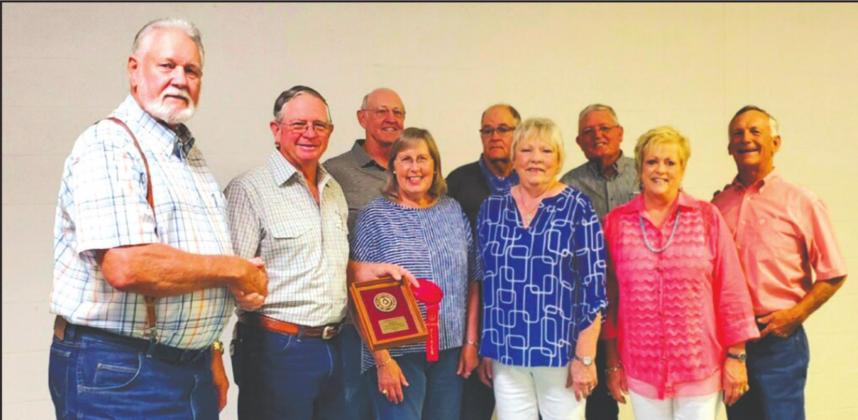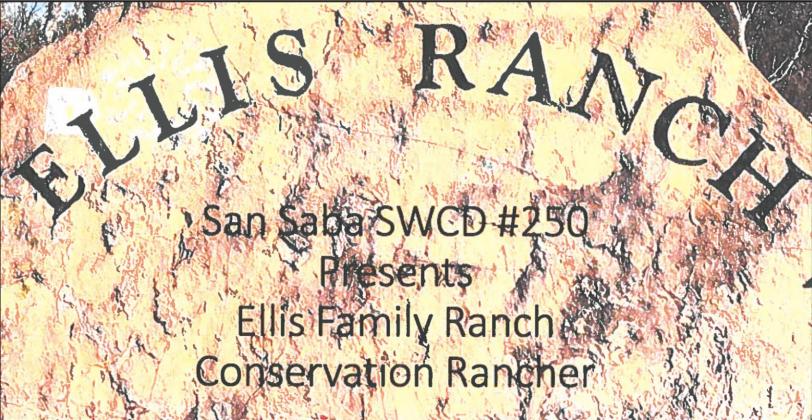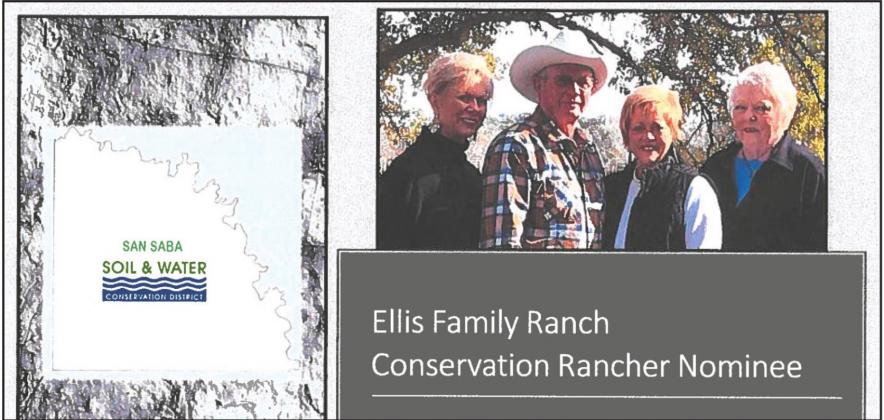The Texas State Soil and Water Conservation Board recently held its annual contest of conservation awards. Area 2 contains 50 districts that range from the western border of Texas down south and over to Interstate Highway 35.
The San Saba Soil and Water Conservation District #250 would like to congratulate our Area 2 winner. It was a great honor for our district to award the Ellis Family Ranch as the winner of this award. Congratulations to a very deserving ranch. Here’s their family story:
The Ellis Family Ranch, located in San Saba County, is a cow-calf operation that was established in 1856 by Henry W. Ellis and T. A. Sloan. Today, their great-grandchildren have taken over the daily operations of the ranch with a goal to increase livestock forage production by improving the soil’s health. The original ranch has since been divided amongst generations. Siblings: Joe Ellis Jr., Cheryl Ellis Hinyard, Sylvia Ellis Taylor, Mary Jo Ellis Smith, and their spouses now operate approximately 2,932 acres of the original ranch. Each sibling operates their own ranch individually, how-ever, many decisions are made with the assistance of each other. The Ellis Family has partnered with the San Saba Soil and Water Conservationist District and Natural Resources Conservation Service for several decades and are dedicated to conserving the land’s natural resources for future generations.
The Ellis Family works closely with the San Saba SWCD and NRCS to implement conservation plans to meet their goals and objectives of increasing livestock forage production while improving the soil’s health. Over the past years, they have utilized the Environmental Quality Incentives Program and Conservation Technical Assistance to assist them with implementing conservation practices. Joe stated, “Since working with the San Saba SWCD and NRCS, we have noticed a better density of desirable grasses due to the removal of competition imposed by undesirable brush and by implementing range planting.”
Brush Management has been the core of their conservation plan. Mechanical brush management is implemented to control ashe juniper and mesquite on their most productive soils. They keep forage production in mind when determining where they’d like to treat undesirable brush species. They also consider economics and utilize the most cost-effective treatment method. Some of the brush management has been completed by using a dozer. However, they have also utilized an excavator on re-sprouting species, such as mesquite, to ensure that the brush is initially controlled as efficiently and effectively as possible.
Pastures which lack desirable plant diversity are reseeded with native plant mixes following mechanical brush management. Millet and sorghum almum are often added to the mix to ensure plant establishment occurs as soon as possible to prevent soil erosion. These species serve as a nurse crop until the native plants are well established and were chosen to increase livestock forage production, improve plant diversity, and enhance seed production for migratory and song birds. Some of the common species that have been planted include: Big Bluestem, Indiangrass, Sideoats Grama, Wilman Lovegrass, Green Sprangletop, and Plains Bristlegrass. Following the range planting, these pastures are deferred from livestock grazing for a minimum of one growing season. The pastures are then evaluated, and a decision is made on whether the pasture is ready for livestock to be reintroduced or if further grazing deferment is needed.
Areas that have been encroached by prickly pear have been treated by aerial chemical brush management. By aerially spraying these areas, the Ellis Family has been able to increase grazeable acres, as well as, forage production. Thistles can also be prominent in their shallow rocky soils and must be sprayed while in the rosette stage to ensure adequate control. They aerially spray the prickly pear in late winter to early spring to serve as a prickly pear and thistle control allowing them to get the most economical control on undesirable species. Following the aerial treatment, they have seen an increase in desirable native grasses and a decrease in annual weeds.
Cross fences were installed throughout the ranches to implement a rotational grazing system and better distribute grazing. These fences have given desirable forages adequate time to rest and reseed. Before the installation of cross fences, livestock continuously grazed the ranches. Since the installation of these fences, the Ellis Family has seen an increase in forage quality and quantity. Their knowledge of plant identification allows them to properly rotate cattle based on key forage species.
The ranch’s rocky terrain decreases distance to water livestock will travel. Earthen tanks are distributed throughout the ranches, but often go dry during periods of below normal precipitation. The Ellis Family has drilled water wells to make certain that a water supply is available year around. These water wells have solar pumps which have reduced energy use and provide reliable water for livestock. Water storage facilities were installed to meet the livestock water demand and then gravity flow to water troughs in areas which lacked accessibility to water. By implementing livestock watering systems, livestock are now seen grazing areas that were seldomly accessed for grazing before. The enhanced water distribution has increased livestock grazing distribution and forage production resulting in benefits to both livestock and wildlife.
The Ellis Family has taken the conservation practices that they have implemented one step further by establishing a proper stocking rate. Livestock grazing is managed to match the available forage with livestock demand. They are flexible with their livestock numbers which allows them to ensure adequate plant diversity, and production persists. Herd numbers have been reduced to allow for implemented conservation practices to become established before introducing livestock back onto these disturbed areas. Adequate rest is provided to each pasture following the implementation of conservation practices. Cattle are then rotated throughout the multiple pastures based on forage availability and plant height of key forage species.
The implementation of conservation practices are also completed with a goal to improve wildlife habitat. Brush management is completed in mosaic patterns, and range planting has increased fawning cover and seed production for dove, turkey, and quail. They are all members of the Southwest San Saba Wildlife Association where they keep records of body weight, antler measurements, and animals’ ages on all harvested white tailed deer. Annual spot light counts are completed to estimate the whitetailed deer population. This data is then reviewed annually by a Texas Parks and Wildlife Biologist to determine population health and dynamics. Protein is provided for white-tailed deer during periods when native vegetation is unavailable due to drought and/or other weather conditions. A management plan is also in place to ensure trophy bucks are 4 1/2 years or older before they are harvested. Sylvia stated, “Since completing conservation practices, we have seen an increase in the body weight of white-tailed deer harvested.”
The Ellis Family is also very involved within the community. Joe is the president of the Southwest San Saba Wildlife Association, Clerk of the Session at New Hope Presbyterian Church, and a member of the San Saba Historical Society, Texas Southwestern Cattle Raisers Association, and National Cattleman’s Beef Association. Cheryl serves as an Elder at New Hope Presbyterian Church and is a Texas Southwestern Cattle Raisers Association member. Sylvia is a member of the New Hope Presbyterian Church. Mary Jo is a member of the First United Methodist Church in Clovis, New Mexico. Their dedication to conservation reflects their desire to leave the land better than they received it for future generations just like their great-grandfathers did when they founded the ranch in 1856. They have created an ever-lasting legacy of conservation by working in conjunction with the San Saba SWCD and NRCS. It is with great honor that the San Saba SWCD nominates the Ellis Family Ranch for Conservation Rancher.



